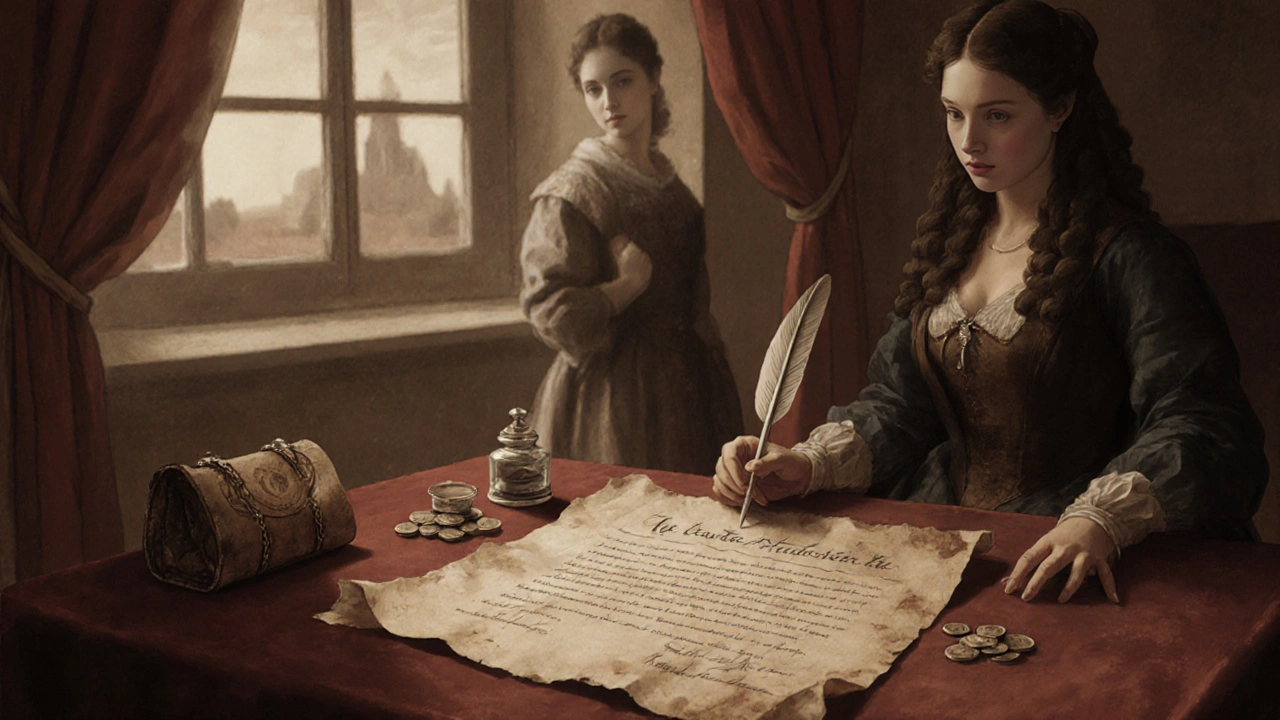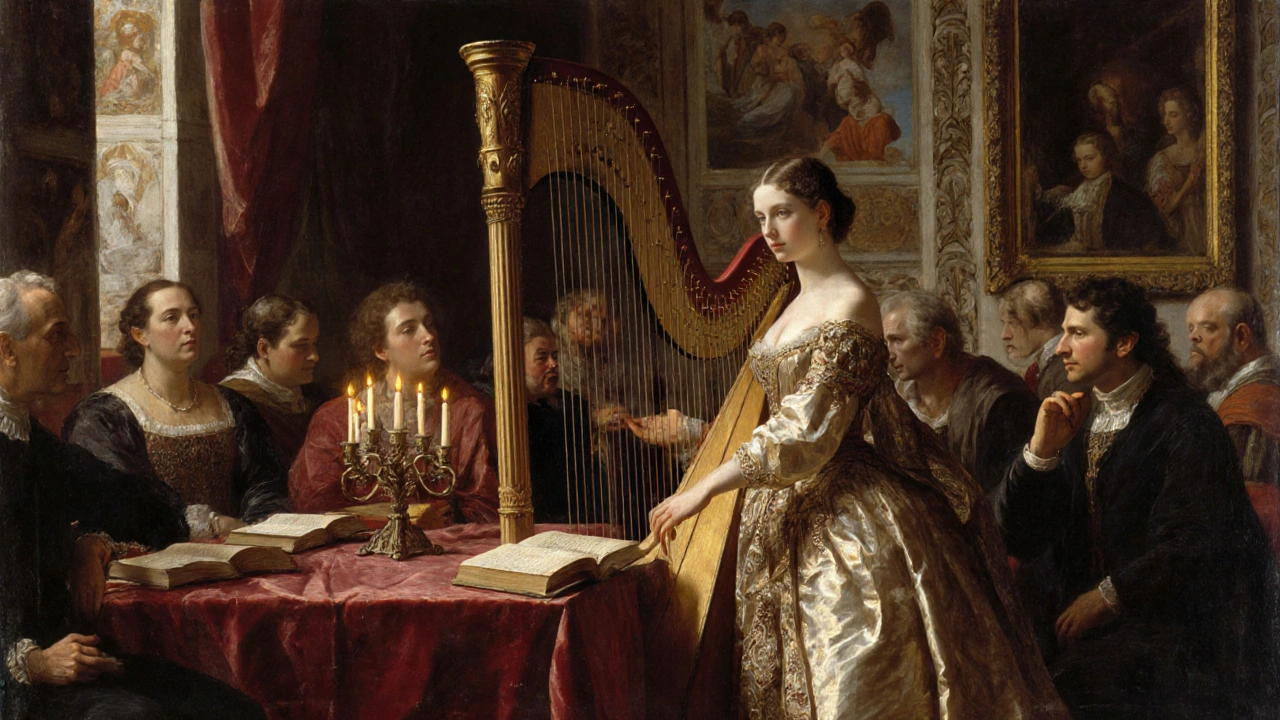Curious about how courtesans influenced women’s rights? Many assume they were just glamorous companions, but their real impact ran deeper-challenging norms, gaining financial independence, and carving out space for women in a world that rarely gave them control. This isn’t about romance or scandal. It’s about how some women used intelligence, charm, and strategy to rewrite the rules-even if they weren’t trying to be feminists.
What Exactly Was a Courtesan?
A courtesan wasn’t a prostitute. She was a highly educated woman who offered companionship, conversation, art, and sometimes sex-but on her own terms. Think of her as a cross between a modern influencer, a political advisor, and a cultural tastemaker. In Renaissance Italy, 18th-century France, or Edo-period Japan, courtesans were trained in music, poetry, philosophy, and etiquette. Their value wasn’t just physical-it was intellectual and social.
Unlike common prostitutes, courtesans often lived in luxury, owned property, and had patrons who included kings, philosophers, and artists. In Venice, a top courtesan could earn more than a university professor. In Japan, oiran were celebrities whose fashion choices dictated trends across Tokyo. Their power came from choice: they selected who they spent time with, set their own prices, and could leave a relationship when it no longer served them.
Why Does This Matter for Women’s Rights?
Courtesans didn’t fight for suffrage or equal pay, but they proved women could thrive outside marriage and male control. In a time when most women had no legal right to own property, inherit money, or divorce, courtesans did all three. They built wealth, funded charities, and even supported other women. Some left fortunes to female relatives or founded schools for girls.
They also challenged the idea that a woman’s worth depended on purity. By openly owning their sexuality and intelligence, they forced society to see women as complex beings-not just wives or nuns. Think of Veronica Franco in Venice, who published poetry defending women’s intellect and criticized male hypocrisy. Her writings were read across Europe. That kind of public voice was nearly impossible for married women to achieve.
How Did Courtesans Gain Power?
- Education - They were taught to read, write, debate, and play instruments, often better than noblewomen.
- Networking - They hosted salons where thinkers, artists, and politicians gathered. These were early versions of professional networking events.
- Financial Control - They negotiated contracts, kept their own earnings, and sometimes invested in real estate or businesses.
- Public Influence - Their opinions shaped fashion, art, and even politics. A courtesan’s favor could make or break a politician’s career.
- Autonomy - They chose their patrons, ended relationships, and could retire with dignity-something few women could do.

Pros and Cons
| Pros | Cons |
|---|---|
| Could earn more than most men in skilled professions | Still faced stigma and moral judgment |
| Owned property and controlled their finances | Had no legal protection if a patron abandoned them |
| Had access to education and culture | Could be imprisoned or exiled if they angered powerful men |
| Could retire with wealth and independence | Often died young from disease or stress |
| Influenced art, literature, and social norms | Their legacy was erased or twisted by male historians |
When Was Their Influence Strongest?
Their peak power came between the 1500s and late 1700s, especially in places like Venice, Paris, and Kyoto. In Venice, courtesans were so respected that they were allowed to sit beside nobles at public events. In Paris, Madame de Pompadour wasn’t just Louis XV’s lover-she ran his cultural policy and chose his ministers.
In Japan, the pleasure districts of Yoshiwara became centers of artistic innovation. Courtesans inspired ukiyo-e prints, fashion trends, and even early forms of celebrity culture. Their influence faded as industrialization rose and Victorian morality took hold. By the 1800s, laws began restricting their freedom, and society pushed women back into domestic roles.

Common Mistakes to Avoid
- Confusing courtesans with prostitutes - They were not the same. Courtesans had education, choice, and status. Reducing them to sex workers erases their real achievements.
- Assuming they were victims - While some entered the life under pressure, many chose it because it offered more freedom than marriage. Treating them as passive figures ignores their agency.
- Thinking their impact was minor - Their salons were incubators for Enlightenment ideas. Women like Madame de Staël and Ninon de Lenclos influenced political thought, literature, and even revolutions.
- Ignoring their role in art and culture - Courtesans commissioned paintings, funded theaters, and wrote books. They didn’t just sit for portraits-they created the culture around them.
FAQ
Were courtesans considered respectable in their time?
It depended on the city and century. In Renaissance Venice and 18th-century Paris, top courtesans were treated like aristocrats-they wore silk, owned carriages, and were invited to royal courts. But they were never fully accepted by the nobility. Their respect was conditional, based on usefulness, not morality.
Did courtesans have any legal rights?
Mostly no. They couldn’t vote, inherit titles, or sue in court like men. But many used contracts to protect themselves-written agreements with patrons that guaranteed housing, income, or pensions. Some even had these contracts notarized. That level of legal foresight was rare for any woman at the time.
How did courtesans influence feminism?
They didn’t call themselves feminists, but their lives proved women could be independent, intelligent, and financially powerful without men. Their existence made it harder to claim that women were naturally inferior or only fit for domestic life. Later suffragists cited courtesans as proof that women could thrive outside marriage.
Why aren’t courtesans taught in history classes?
Because history was written by men who wanted to preserve traditional gender roles. Courtesans threatened the idea that women needed male protection. Their stories were either ignored, romanticized, or turned into cautionary tales. Only recently have scholars begun to recover their real legacy.
Are there modern equivalents to courtesans?
Not exactly-but some modern influencers, high-end companions, and female entrepreneurs share traits: financial independence, public influence, and control over their image. The key difference? Today’s women have legal rights courtesans never did. Still, the courage to define success on your own terms? That hasn’t changed.
What’s Next?
If you want to dig deeper, read Veronica Franco’s poetry or watch the documentary Courtesans of the World. Visit the Museo Correr in Venice or the Yoshiwara archives in Tokyo-both hold original letters and contracts from courtesans. Their voices are still there. You just have to listen past the myths.





Michelle Clark on 22 November 2025, AT 04:21 AM
This is such a refreshing take. I never realized how much agency these women had. They weren't just 'kept women'-they were CEOs of their own brand, with contracts, investments, and cultural clout. The fact that they funded schools for girls? That’s the kind of legacy we should be teaching in schools, not just the myths.Also, Veronica Franco’s poetry? Absolute fire. Someone needs to make a TikTok series on her.